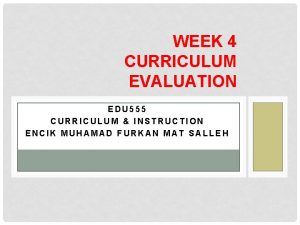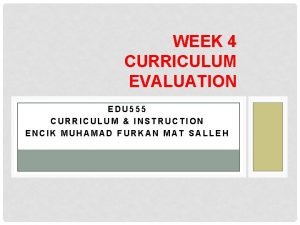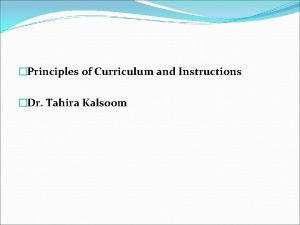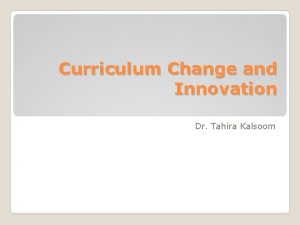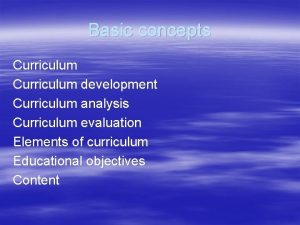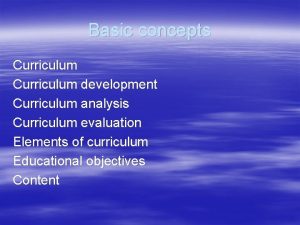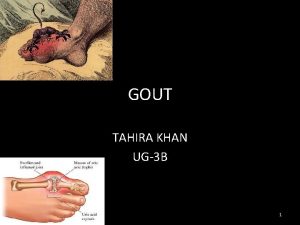Curriculum Evaluation Dr Tahira Kalsoom The Five Ps















- Slides: 15

Curriculum Evaluation Dr. Tahira Kalsoom

The Five Ps Program Provisions Procedures Products Processes

Evaluation The means for determining what needs improvement and for providing a basis for effecting that improvement Measures achievement, instructor’s performance, effectiveness of a particular approach or methodology Problems in evaluation What should we be able to tell? P. 439

Scope - select topics to be studied and specify the instructional objectives Relevance - congruence between the entire school system and the social order Balance - maintain certain sets of elements proportionately Integration - unify subject matter

The Curriculum Model Components: Curriculum goals Curriculum objectives Organization Implementation Evaluation: Takes place before, beginning, end

Evaluation Models The Saylor, Alexander, and Lewis model- seek evaluation of these components: The goals Sub goals Objectives The program of education a a totality Specific segments of the education Instruction and evaluation program

CIPP model CIPP is a decision-focused approach to evaluation and emphasises the systematic provision of information for programme management and operation. In this approach, information is seen as most valuable when it helps programme managers to make better decisions, so evaluation activities should be planned to coordinate with the decision needs of programme staff. Data collection and reporting are then undertaken in order to promote more effective programme management. Since programmes change as they are implemented, decision-makers needs will change so the evaluation activities have to adapt to meet these changing needs as well as ensuring continuity of focus where appropriate in order to trace development and performance over time.

Conditions of Evaluation There are many different definitions of evaluation, but one which reflects the CIPP approach is the following: ‘Programme evaluation is the systematic collection of information abut the activities, characteristics, and outcome of programmes for use by specific people to reduce uncertainties, improve effectiveness, and make decisions with regard to what those programmes are doing and affecting’ (Patton, 1986: 14).

Purpose of Evaluation Stufflebeam sees evaluation’s purpose as establishing and providing useful information for judging decision alternatives; assisting an audience to judge and improve the worth of some educational programme or object; assisting the improvement of policies and programmes.

The CIPP model of evaluation Aspect of evaluation Type of decision Kind of question answered Context evaluation Planning decisions What should we do? Input evaluation Structuring decisions How should we do it? Process evaluation Implementing decisions Are we doing it as planned? And if not, why not? Product evaluation Recycling decisions Did it work?

Basic Questions to be answered The four aspects of CIPP evaluation (context, input, process and outputs) assist a decision-maker to answer four basic questions: What should we do? This involves collecting and analysing needs assessment data to determine goals, priorities and objectives. For example, a context evaluation of a literacy program might involve an analysis of the existing objectives of the literacy programme, literacy achievement test scores, staff concerns (general and particular), literacy policies and plans and community concerns, perceptions or attitudes and needs.

Basic Questions to be answered 2. How should we do it? This involves the steps and resources needed to meet the new goals and objectives and might include identifying successful external programs and materials as well as gathering information 3. Are we doing it as planned? This provides decision-makers with information about how well the programme is being implemented. By continuously monitoring the program, decision-makers learn such things as how well it is following the plans and guidelines, conflicts arising, staff support and morale, strengths and weaknesses of materials, delivery and budgeting problems.

Basic Questions to be answered 4. Did the programme work? By measuring the actual outcomes and comparing them to the anticipated outcomes, decision-makers are better able to decide if the program should be continued, modified, or dropped altogether. This is the essence of product evaluation.

four types of evaluation: context, input, process, and product four types of decisions: planning, structuring, implementing and recycling

Models can be used independently or in conjunction with each other.
 Tahira rehman
Tahira rehman Kalsoom tariq
Kalsoom tariq Instrument for curriculum evaluation
Instrument for curriculum evaluation Curriculum evaluation
Curriculum evaluation Cipp evaluation model
Cipp evaluation model Learning is explained in terms of wholeness of the problem
Learning is explained in terms of wholeness of the problem The sounding cataract haunted me
The sounding cataract haunted me One in five challenge
One in five challenge 5 senses and 5 elements
5 senses and 5 elements The devil damn thee black
The devil damn thee black Các châu lục và đại dương trên thế giới
Các châu lục và đại dương trên thế giới Thế nào là hệ số cao nhất
Thế nào là hệ số cao nhất Sơ đồ cơ thể người
Sơ đồ cơ thể người Tư thế ngồi viết
Tư thế ngồi viết Cái miệng bé xinh thế chỉ nói điều hay thôi
Cái miệng bé xinh thế chỉ nói điều hay thôi Hát kết hợp bộ gõ cơ thể
Hát kết hợp bộ gõ cơ thể



